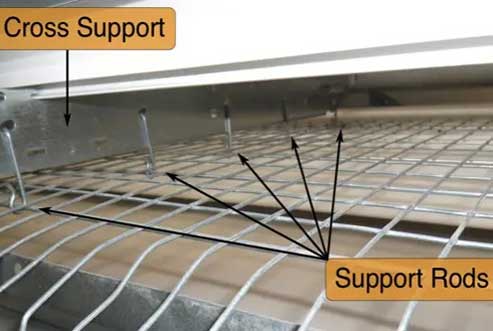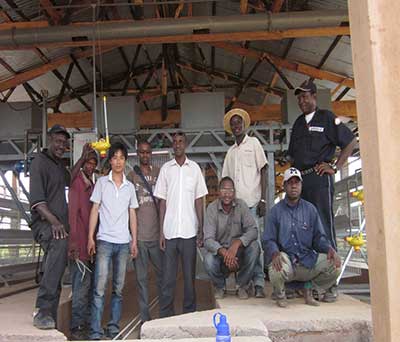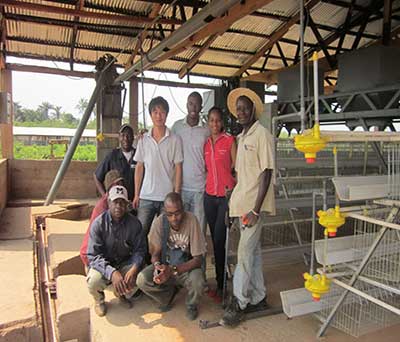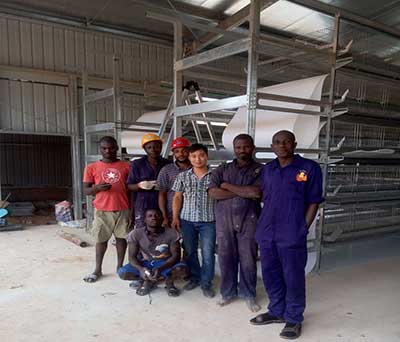
- Product Name: Enriched Chicken Cage
- Main usage: Provide laying hens a free environment for activities.
- Size/Tier: Customized according to requirements.
- Warranty: 1 year
- Feature: Providing chicken welfare without the use of chicken cages.
Enriched chicken cages introduction
In 2005, the UK’s first charity dedicated to improving the welfare standards of laying hens was established. In 2012, European countries banned the use of traditional battery cages, making enriched cages a viable alternative. By 2015, California in the United States prohibited the confinement of pregnant sows, veal calves, and laying hens in traditional narrow stalls or poultry cages. Farmers were required to provide sufficient space for the animals to lie down, stand up, fully stretch their limbs (or wings), and turn around freely.
It was in this context that enriched cages were introduced. Also known as furnished cages, enriched chicken cages, colony cages, or enriched cages for laying hens, they are a type of poultry housing designed to meet higher welfare standards. Each poultry house is equipped with a spacious outdoor “playground” that includes sunning perches, allowing hens to enjoy the sunshine freely. Hens live alongside roosters for company in an open yard. Under the eaves, rows of water troughs and feeders are neatly arranged. Inside the poultry house, conveyor belts deliver freshly laid eggs directly from the hens to the hands of the farmers.
Features and advantages of AGICO enriched cages
- The advanced feeding system provides a feed trough with a length of at least 12 cm multiplied by the number of hens in the enriched cage, ensuring unrestricted access for all hens. Each enriched cage is also equipped with a suitable drinking system that guarantees every hen can access at least two nipple drinkers or two water cups.
- AGICO enriched cages have an automatic egg collector, an egg protection line, and an extra-wide egg belt, enabling gentle and efficient egg handling.
- The enriched cages include nest boxes for hens to lay eggs and roost, fulfilling their natural nesting instincts. They are also equipped with scratch mats to simulate natural foraging and exploration behaviors, allowing hens to peck and scratch freely. Additionally, each hen is provided with at least 15 cm of perch space, enabling natural resting and roosting, similar to their behavior in the wild.
- Each laying hen is allocated a minimum of 750 square centimeters of cage space, with aisle widths between cages being at least 90 cm and a clearance of at least 35 cm between the cage floor and the building floor. This ensures sufficient space for hens to turn around and stretch their wings.
- The design of AGICO enriched cages considers manure cleaning and ventilation, effectively reducing ammonia levels and bacterial growth in the coop. This not only promotes the healthy growth of hens but also minimizes the risk of disease transmission during farming, improving overall farming efficiency.




enriched cages applications
Economic Feasibility: Enriched cages are suitable for economically developed regions or large-scale farmers with sufficient funds to invest in well-equipped cages, nest boxes, perches, high-quality ventilation, and temperature control systems.
Environmental Requirements: Welfare-focused poultry farming requires relatively stable and suitable environmental conditions for temperature, humidity, and ventilation. Therefore, enriched cages are typically used in areas with flat terrain and convenient access to water and soil resources.
Technical Expertise: Enriched cage farming requires proficiency in poultry management, including behavioral management, nutrition planning, health monitoring, disease prevention, and environmental control. This approach demands a high level of farming expertise.
Strict Welfare Regulations: In regions with stringent animal welfare standards, such as some EU countries, traditional battery cage systems are prohibited by law. Enriched cages comply with these regulations, making them a preferred choice in such areas.


Comparison Between Enriched Cages and Aviary Systems
Structural Differences
Enriched Cages: These are improved versions of traditional battery cages, featuring a closed single-layer or multi-layer design. Chickens live inside the cages, which are larger than conventional battery cages, typically housing 4-10 laying hens per cage. They are equipped with features such as perches, nesting boxes, scratching mats, and dust bathing areas, allowing hens more space and opportunities to perform natural behaviors.
Aviary Systems: Aviary systems are multi-tiered, open housing systems that provide a cage-free environment. Chickens can move freely, jump between tiers, walk, and perch, offering them a larger activity area and more natural behaviors. These aviary systems include perches, nesting zones, feed troughs, water systems, manure collection, and drinkers.
Application Regions
Enriched Cages: These systems are suitable for regions with moderate welfare requirements that still allow cage-based systems. For example, some European countries have promoted enriched cages after banning conventional battery cages. Eggs are usually labeled as “enriched cage” and are less expensive than aviary system eggs but more expensive than traditional caged eggs. With controlled environments and limited activity for hens, enriched cages for laying hens often yield higher egg production rates and lower mortality rates, though egg quality might not match that of aviary systems.
Aviary Systems: Aviary systems are popular in regions with stricter animal welfare demands, such as parts of the European Union, certain U.S. states, and Japan, where there is growing demand for “cage-free” eggs. Eggs are typically labeled as “cage-free” or “free-range” and command higher prices. Laying hens in these systems are more active, potentially resulting in slightly lower production rates but higher egg quality (e.g., stronger shells, and richer yolk color). Hens maintain better body condition, though mortality rates may be higher than in caged systems.
Market Positioning
Enriched Cages: Enriched cages are considered transitional systems between traditional cages and fully free-range systems. They meet minimum welfare standards in regions like the EU, making them a compromise option.
Aviary Systems: Aviary systems represent a high-end, cage-free solution, meeting the requirements of the “free-range” or “cage-free” egg market. They align with modern animal welfare laws and consumer expectations for “humane farming,” and are widely adopted in areas like the EU and Canada.
Animal Welfare
Enriched Cages: These cages provide limited but sufficient space for basic natural behaviors such as perching, scratching, and nesting. The smaller group sizes and physical separation reduce risks of feather pecking and disease transmission. However, restricted movement may result in less muscle and bone development compared to aviary systems.
Aviary Systems: These systems closely mimic natural ecosystems, allowing hens to exhibit more natural behaviors such as foraging, perching, and wing-stretching. The increased activity helps improve their physical condition and reduces health issues like skeletal problems. However, the higher freedom of movement may increase risks of feather pecking, parasite infestations, and management challenges.

Environmental Control
Enriched Cages: The enclosed environment makes it easier to control temperature, humidity, and hygiene. Manure drops directly into collection systems beneath the cages, simplifying waste removal.
Aviary Systems: The open design and multi-tiered structure require more advanced temperature, humidity, and air quality control. Manure management can be more complex due to chickens’ wider activity range, which may lead to sanitation challenges.
Management and Costs
Enriched Cages: The investment cost is lower than for aviary systems but higher than traditional cages. They are simpler to operate and suitable for small to medium-sized farms or those transitioning to higher welfare standards.
Aviary Systems: These systems require more advanced management skills and equipment, with higher initial investment and operational costs. They are better suited for markets demanding high egg quality and welfare standards.








